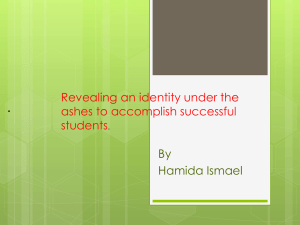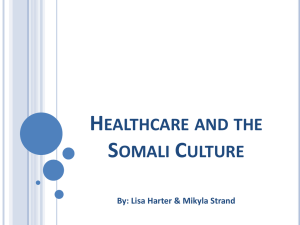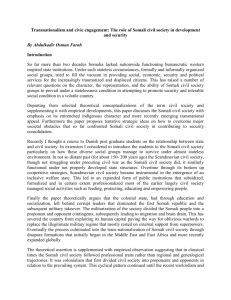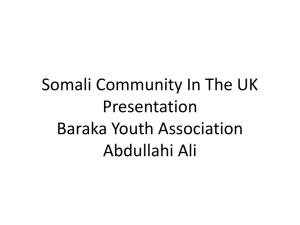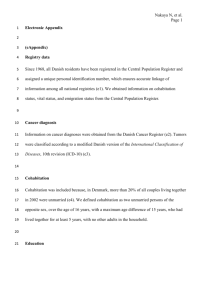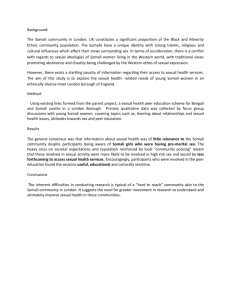Remittance, Integration and Diaspora Introduction S omali migration
advertisement
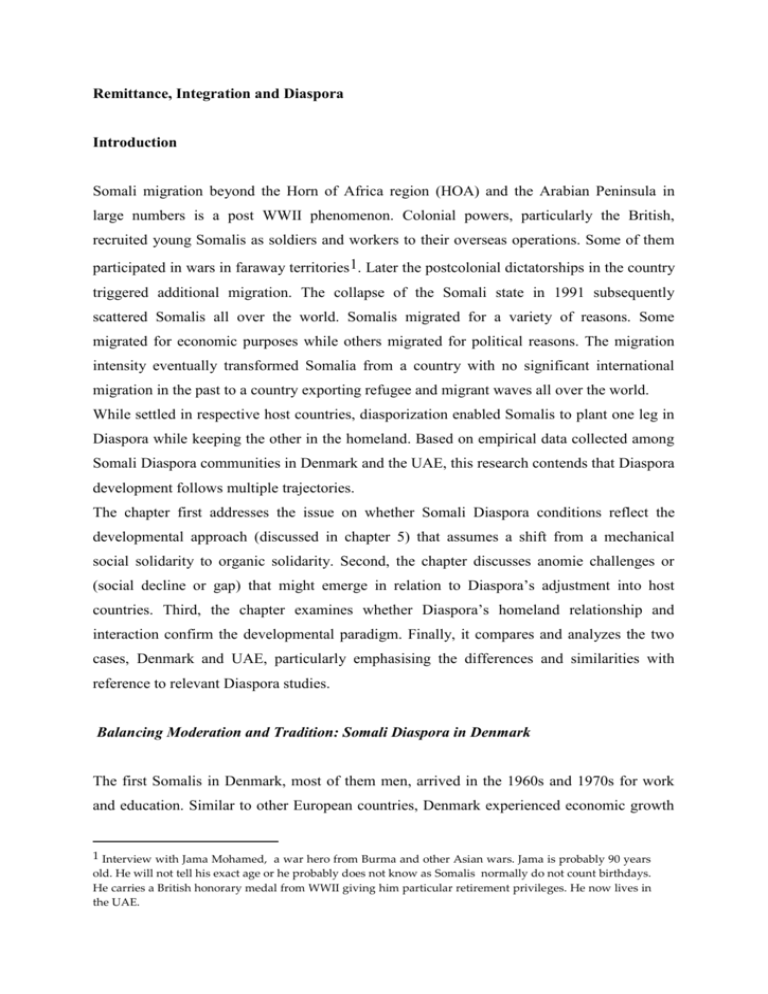
Remittance, Integration and Diaspora Introduction Somali migration beyond the Horn of Africa region (HOA) and the Arabian Peninsula in large numbers is a post WWII phenomenon. Colonial powers, particularly the British, recruited young Somalis as soldiers and workers to their overseas operations. Some of them participated in wars in faraway territories1. Later the postcolonial dictatorships in the country triggered additional migration. The collapse of the Somali state in 1991 subsequently scattered Somalis all over the world. Somalis migrated for a variety of reasons. Some migrated for economic purposes while others migrated for political reasons. The migration intensity eventually transformed Somalia from a country with no significant international migration in the past to a country exporting refugee and migrant waves all over the world. While settled in respective host countries, diasporization enabled Somalis to plant one leg in Diaspora while keeping the other in the homeland. Based on empirical data collected among Somali Diaspora communities in Denmark and the UAE, this research contends that Diaspora development follows multiple trajectories. The chapter first addresses the issue on whether Somali Diaspora conditions reflect the developmental approach (discussed in chapter 5) that assumes a shift from a mechanical social solidarity to organic solidarity. Second, the chapter discusses anomie challenges or (social decline or gap) that might emerge in relation to Diaspora’s adjustment into host countries. Third, the chapter examines whether Diaspora’s homeland relationship and interaction confirm the developmental paradigm. Finally, it compares and analyzes the two cases, Denmark and UAE, particularly emphasising the differences and similarities with reference to relevant Diaspora studies. Balancing Moderation and Tradition: Somali Diaspora in Denmark The first Somalis in Denmark, most of them men, arrived in the 1960s and 1970s for work and education. Similar to other European countries, Denmark experienced economic growth 1 Interview with Jama Mohamed, a war hero from Burma and other Asian wars. Jama is probably 90 years old. He will not tell his exact age or he probably does not know as Somalis normally do not count birthdays. He carries a British honorary medal from WWII giving him particular retirement privileges. He now lives in the UAE. and invited “gæstearbejdere” (Kureer, Henrik & Lundgren, Svend Erik, 2006: 101). The second group, who included political refugees, came from the mid 1980s onwards. The group constituted diverse opposition groups at the time opposing the military regime. From the 1990s, following the collapse of the military regime and the subsequent mayhem, mostly vulnerable and traumatized Somalis joined the influx. Table 7.1 Somalis in Denmark As table 7.1 shows in early 2001 Danish statistics on immigrants there are 16.493 Somalis in Denmark. Out of this number 8.829 are men, whereas 8.114 are women. The number of Somalis in Denmark between 0 up to 19 years is 6.832 , whereas Somalis we could describe as youth between 20 up to 40s constitute 4.431 persons. That means more than 2/3 of the Somalis can be described as young and children. This tells us that many Somalis in Denmark are still children and thereby not available for the job market. When discussing the number of Somalis at work in Denmark this fact is not often included. If one deducts the number of aged people and those sick or traumatised then less Somalis seem ready for taking Jobs. The statistics further indicate that the Somali presence in Denmark is future oriented as most are either born or grown in the country. However, in recent years job opportunities for the Somalis and many other immigrants improved due to the combination of economic growth and restrictive welfare rules. The following table 7.2 shows that the number of Somalis getting jobs in Denmark has increased. The longer people stay the closer they become of getting a job. This reflects Somalis adjusting into the country by learning the language and getting the training needed to get a job in Denmark. Table 7.2 Somali employment and years of residence in Denmark Table 7.3 Somali asylum application in Denmark since 1990 Table 7.3 shows that the number of Somalis applying for asylum in Denmark both from within the country and abroad increased. The number of Somali refugee increased during 1990s following the deteriorating conditions in Somalis and flexible family reunion possibilities in Denmark at the time. Since 2001, Denmark has not been a refugee destination (Stephen, 2005: 25). Due to the changes in both asylum and integration laws, it has become difficult to access Denmark. Although, Somalis first arrived in large numbers to Denmark in the early 1990s, the Danish public and the authorities did not pay particular attention to this culturally dissimilar people. The Danish nuclear family structure is strange to the Somalis in Denmark. In Somali culture the family conception includes the extended family. Hence, the Somalis bringing their extended family to Denmark outraged the general public opinion as the Danes considered the practice as an abuse of the asylum they received in Denmark and the Danish social welfare system2. Alleged practices of FGM (female genital mutilation) further undermined Somali image in Denmark3. Consequently, this led to the introduction and implementation of the restrictive Danish immigration laws. DNA tests were introduced to prevent the reunion of extended family members. In part the arrival and the presence of Somalis and other immigrants and refugees from developing countries generated the introduction of restrictive legislation of foreigners in Denmark. 2 23rd May 1997 Extra bladet a tabloid newspaper in Denmark published an article discussion Ali a Somali from Northern Somalia who was married and had about 11 children. He was on welfare. The article described the Somalis people who are not genuine refugees but came to Denmark to exploit the welfare system. This was the start of negative attitude towards the Somalis that still prevail. 3 19th November 2002 the Danish newspaper Published an article with a Somali Imam from Aalborg who earlier in the week supported genital female mutilation (FGM) but later dismissed the allegation. As the following statement suggests in general, despite certain reservations and cultural complaints, Somalis seem enthusiastic about life in Denmark. This is mainly because Somalia belongs to the least developed countries in the world, while Denmark qualifies as one of the most prosperous countries in the world4: For us, Diaspora is freedom, development, meeting with other people, opportunity to learn and interact with other nations. We left from our country for two main reasons. The poverty of the region where we are from and the security problems due to civil wars and qabiilsm, we could not live there. We also want to get education (Abdulrahman, Denmark, 2009) When Somalis receive formal refugee status and resident permit, Danish authorities offer them housing, education and language training. The so-called integration process starts. Later, people acquire citizenship and create their own individual or group Somali-Danish identity. Since mid 1990s the number of Somalis who got Danish citizenship increased. In the past few years the number of Somalis obtaining Danish citizenship decreased following the introduction of restrictive naturalization laws. Table 7.4 Danish nationality for Somalis from 1979-2010 4 Human development index, 2010, Denmark ranks nr. 19. in global ranking, for Somalia, the index says “information not available”, but Somalia belongs to one of the poorest countries in the world. In general, Somalis acquire socio-economic and political benefits, rights and access to a new country that is more prosperous and more enlightened; a country that provides them with education, economic and citizenship opportunities. As table 7.4 these opportunities impact Somali families, the Diaspora community and their relationship with the homeland. Somalis often move to major cities for social, friendship and networking reasons. The city environment provides better network and opportunities and attracts diverse immigrants including the Somalis. Obviously, the structural, social, economic and political conditions in Denmark influence the Somali community and their internal and external social relations. Post-independent Somali states operated under personal and militaristic rule as their colonial predecessors. Therefore social solidarity among the Somalis mainly rested on mechanical solidarity (assabiya). The extended family and the qabiil provided basic social solidarity and insurance. Following the arrival of Somalis in Denmark, such relationships might come under pressure as Somalis access new opportunities in a more developed country and state that aim at integrating ethnic minorities into the society. The question is whether Somalis continue to maintain their old social relations based on family centred kinship relations or whether they will adapt new forms of social relations. To a certain extent, it seems that Somalis in Denmark adjust to the structural opportunities in the country. In the Danish case, the new socio-economic conditions challenge the traditional Somali social solidarity and hierarchy in several ways. First at community level, Somali Diaspora seems to replace kinship (assabiya) solidarity with religious (assabiya). Instead of organizing through kinship lines, Somalis organize through religious and other neighbourhood and friendship lines. This does not however mean kinship affiliations disappear from the Somali consciousness. Second, following the welfare opportunities in Denmark, Somali Diaspora’s family cohesion comes under pressure from gender conflicts and intergenerational gaps. Thirdly remittances to the homeland gradually shift from a relative and family oriented transaction during the initial stages of residence in Denmark to a more institutional and ideological-oriented homeland investment and humanitarian assistance. Declining Kinship Assabiya and Emerging Religious Assabiya Kinship relations represent an important social factor among the Somalis both in the homeland and in Diaspora. Community networking often involves kinship dynamics influencing the cohesion and conflict among Somalis. The question is whether this relationship represents the continuity of homeland traditions, or it reflects socio-economic and political conditions, a sort of anomie, that Diaspora confront in the host country. Financially, Somalis in Denmark depend less on kinship relations. The relative economic independence influences the maintenance of cliental kinship as Somalis modify the practice with nationalistic and religious activities. Thus, kinship loses its major organizing social role among the Somalis in Denmark: In Denmark Somalis are mixed. Everybody participates weddings and funeral people help each other. There are no obvious qabiils, The qabiils have no monopoly here. If people stayed with their qabiil, so there would have been a problem (Abdi, Denmark, 2010) For Abdi, a 38 year-old community organizer, Somalis abandon qabiilism and increasingly organize through religious-inspired community associations rather than kinship-related relationships. According to him, such developments reflect the Danish socio-political context attributing less significance to kinship relations. He predicts the qabiil phenomenon gradually losing prominence among the Somalis. In this regard, Somalis seem to adjust. But Abdi sees Somalis instead organizing in religious associations. Abdi’s observation might reflect his position and status in the Somali Diaspora. He is not just a respected community leader and organizer, but he is also a member of Pan-ethnic transitional organization that campaigns for Islamic revivalism akhwan al-muslimiin (Muslim brotherhood). A study conducted by Lene Kühl from Aarhus University confirms that Somalis are among those ethnic communities that organize themselves around cultural centres or religious institutions. Religious elites often led by Sheikh (religious scholar) dominate structures and decisions in such institutions (Kühl, 2006: 11-17). The tendency to de-traditionalize might also reflect historical grievances. For some members, severing qabiil relations means distancing from the homeland civil war. Migration and settlement in a country with no obvious kinship relations provides such opportunity. In Denmark, religion and being religious play a central role among the Somalis. Somali associations organize and empower youth, women and vulnerable families. Among community activists, there are religious leaders who feel obliged to fill “the religious & organizational gap”. A kind of intergenerational religious gap exists. The parent generation feels insecure with the absence of “proper” religious upbringing of their children in a secularized Danish society. As the political debate on Islam in the west, including Denmark, intensified, so did the extent of Somali community organization through religious activities. Somali communities conduct common annual religious activities, such as the two Eid holidays, with pan Islamic associations. In addition, they organize excursions and participate in religious and cultural festivals5. Denmark is different from other Scandinavian countries. In Sweden, for instance, state and religion are two separate entities. The Danish state, however, constitutionally favours Christianity (Clausen and Mikkelsen, 2005: 40). This makes minority groups, including the Muslims, insecure making them pay more attention to religious aspects. For instance, many Somalis express concern about how to maintain and practise their religion. Religion and being religious is important for the Somali Diaspora as the Somali culture mainly reflects Islam. Although some elements of the culture date back to pre-Islamic periods, Somalis consider their cultural identity resting on Islamic values (Houtsma, 1993: 486). Religion also plays an important organizational role in the community. Mosques, cultural centres and the leaders there represent the core leading institutions. The increased attention to religion creates tension among the community. With regard to Danish society, religion plays a limited role in people’s daily lives. If Danes practise religion, they do it culturally during national holidays or discretely and individually (Ludvigsen, 2007: 121). 5 Interview and discussion with community leaders and activists, February,2010 Gender and Intergenerational Challenges Changes to the Somali family structure represent social transformation process among the Somali Diaspora in Denmark. The first crucial role to change concerns Somali women, who in Denmark occupy the role of the “family leader”. In this regard men appear increasingly marginalized. Compared to Somali men, Somali women in Denmark feel integrated into the Danish welfare system, but they experience exclusion in the employment market coupled with recurring negative political campaigns in a country among the most upfront when it comes to gender equality6. The second social change is intergenerational. Somali youngsters seem to assimilate more in the Danish society by getting better education and leisure time jobs. This creates tension between the old and younger generations. As the following interviewee proposes, tensions seem to rest on the limitations by the parent generation: We Somali parents have no tradition talking to our children. We speak Danish but it is not fluent Danish. Our children speak fluent Danish but they converse in non-fluent Somali. (Iidle, DK, 2008). As young Somalis grow older, their attitudes to the homeland language change. In Denmark, young Somalis, who have grown up or were born in the country, rediscover their Somali identity while in secondary school or at university. Together with Somali peers, they start communicating in Somali. Initially, statements are mixed with Danish phrases but gradually develop to understandable Somali language. From Traditional Remittance to Ideological and Social Remittance The Somali Diaspora relationship with homeland rests on two main interdependent pillars, economic and social relationships. The economic ties include remittances, fundraising and direct investments in the homeland. The social relationship encompasses Diaspora’s frequent interactions with relatives, networks and constituencies in the homeland. At the intermediate level, community associations and Diaspora spaces, initiated and coordinated by traditional, 6 http://hdr.undp.org/en/statistics/gii/ religious, business and professional elites, influence the formation and maintenance of the relationship. Significant portion of the Somali Diaspora constitute refugees who fled their homeland following persecution or the general freedom and economic deterioration under military rule. Many others joined after the collapse of the regime, fleeing from extreme civil war generated perpetual poverty and insecurity. Therefore, Somali Diaspora continues to involve and contribute to homeland developments. Most feel sharing privileges acquired in host countries with the suffering relatives back home. The contribution is not just restricted to economic and humanitarian matters but also involves politics. Such multiple homeland involvements bestow Diaspora members certain status. For instance in returning to the homeland, homeland Somalis receives Diaspora members as heroes, sometimes seem more appreciated and respected than the local leaders. When you return, people in the homeland will welcome you better than their rulers and local chiefs (Mohamud, Denmark, 2008). Mohamud is a prominent activist in the Somali community. He has been in Denmark for the past fifteen years. As a naturalized Danish citizen, he feels privileged to live in Denmark. He believes such privilege provides him income, education and status, which he intends to share with people in the homeland. This can happen through associational and organizational links. Apart from remitting to relatives, together with other religious and associational figures, he mobilizes the community during national disasters and Islamic eid holidays “to not forget their suffering countrymen in the homeland”. On a recent trip to the homeland, he experienced the local community attributing him greater status and respect. He is convinced that his alleviated status in the homeland reflects his presence in a country like Denmark and his community mobilization efforts and remittance. Diaspora finds itself in a precarious situation where they have to deal with challenges both from the host country and homeland simultaneously. Homeland remittance remains key to Diaspora status formation and legitimacy. Whether or not the remittance will continue is rather uncertain. For instance, people who abuse qat seem lost and distant from the homeland. In addition, the young generation who are born here appear not emotionally linked to the extended family in the homeland, which means they might contribute as they potentially can. Thus, Diaspora needs to shift homeland support from remittance-oriented to development and ideology-oriented. Ali is a 41 year-old Somali from urban Somalia. He came to Denmark in 1990 and he did not in person experience the civil war tragedies. As naturalized Danish citizen, he feels integrated into the society in e.g. acquiring Danish education and he currently works in the public sector. He is married and has children. For Ali, remittance is an individual family-related effort to provide these families a minimum income to survive. Due to the security challenges on the ground, remittance is the only option: Remittance is the only support we can give (Ali, Denmark, 2008). Diaspora also remit on special occasions e.g. during homeland natural droughts and other disasters. In addition the community mobilizes resources during religious Islamic festivities such as the two Eid holidays7. Such efforts often occur through organized fundraising where community elites play a central role: We remit and contribute ideas and we have people we share ideas with in the homeland. During Eid holidays we collect money from the community and remit, especially when people suffer from different catastrophes (Abdalaziz, Denmark, 2008). Other Somalis remain sceptical as they expect financial remittances not to change much in the long term. They refer to remittances as not having any significant impact and the practice mainly representing an escape or excuse by the Diaspora for not seriously engaging in proper developmental endeavours. Instead, they suggest, Somalis need to concentrate on overcoming the security challenges and the civil war by contributing to ideological development: We can remit money, but Somalis are divided into Als and qabiils. They will not get progress in Diaspora and in the country. We need ideological and social remittance instead of financial (Kaarshe, Denmark, 2008). Kaarshe is a 60 year-old resident in Denmark. Before the civil war, he was a senior official for the Somali state. For him, remittance is a transitional pain relieving process not pain curing procedure. According to him, the homeland needs intensive progressive ideological 7 Muslims celebrate two major festivities; Eid-alfidr & Eid.aladha that include prayers, sacrifices and presents to family and friends (Winchester, 2000.p. 19). framework where Diaspora engages in social remittance pursuing peace, security and statebuilding initiatives. Others consider efforts to overcome the current remittance dependence more pressing. They do this by providing microcredit for families to invest small income-generating projects. The efforts aim at complementary outcomes. First, to prevent remittances affecting Diaspora in the host country negatively. As remittance is often deducted from Diaspora’s limited income its continuation might negatively impact on Diaspora’s wellbeing in the host country. Hence, Diaspora members consider the replacement of the monthly monetary remittance: We are trying to help Somalia. But in a way where they overcome poverty. We for example invest small projects for about 2000 USD. In this way we will replace dependence on remittance (Mulki, Denmark, 2008). Mulki, a 39 year-old Somali lady in Denmark, married and has several children also remits to the homeland. Together with other Somali women in a Somali women association in Denmark they intend to change the monthly remittance to Somalia to a long term strategy of empowering women and children in the homeland. Mulki and the other ladies in the organization believe that people in Somalia, particularly women, should receive micro-credits of about 2000 USD to make them independent in the long run. Mulki and her friends believe that the monthly remittance negatively affects the children and families’ well-being in Denmark. Despite this, Somali women feel obliged to assist vulnerable people in the homeland. Through the Somali media, such as satellite TVs, Somali Diaspora sees the ongoing suffering of vulnerable Somalis in the homeland8. Such emotional fund-raising programs often attract attention and support from Somali women in the Diaspora, including those from Denmark, who make interventions in these programs and donate. 8 Somali satellite TV with headquarters in London organizes weekly humanitarian programs for Diaspora donation to humanitarian challenges in the homeland ( http://tvuniversal.tv/NS/). References Clausen Allan Friis & Poul Storgaard Mikkelsen (2005). Det multikulturelle samfund - og det danske. Systime. Houtsma M. Th (1993). A. J Brill’s First encyclopaedia of Islam. 1913-1936. Brill. http://wardheernews.com/Articles_09/August/Abow/14_Prof_Dalxa_Vs_Ambassador_Ali_Am erika.html Kureer, Henrik & Lundgren, Svend Erik (2006). International økonomi: B-niveau. SYSTIME. Ludvigsen Lise (2007). Religion i det senmoderne samfund: mellem kritik og forsvar. Systime. Stephen Sarah (2005). Refugees and the Rich-World Fortress. Resistance books.
